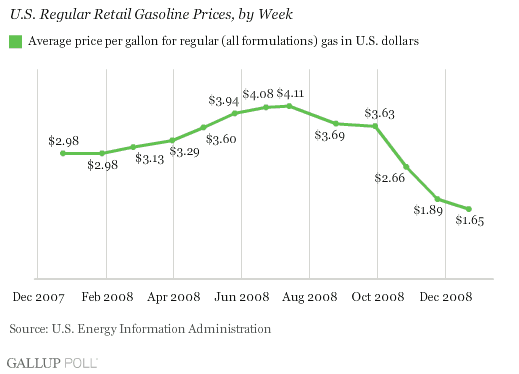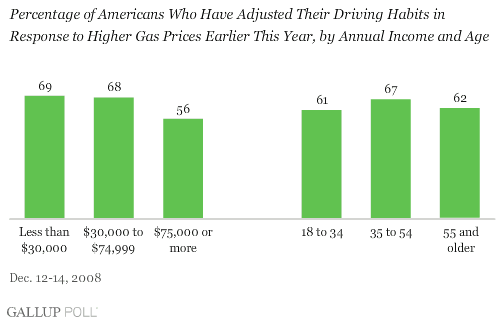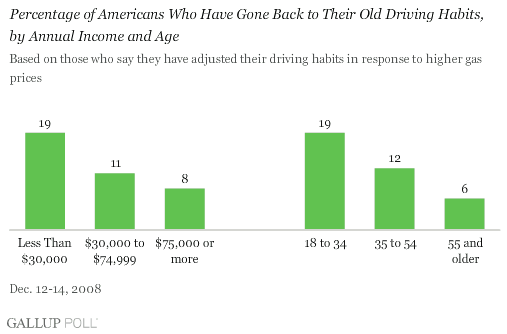PRINCETON, NJ -- Nearly two in three Americans (64%) report adjusting their driving habits in significant ways in response to surging gas prices earlier this year, but only 12% have reverted to their old habits as prices at the pump have plunged. Even as the price of a gallon of gas has fallen below $2 in most areas, 52% of Americans say they have not gone back to their old driving habits.

Upper-Income Americans Least Likely to Have Changed Driving Habits
Gas prices at the pump represent a smaller percentage of disposable income for upper-income Americans than for those making less. As a result, it is not surprising that lower- and middle-income respondents (those whose annual household income is less than $75,000) are more likely than upper-income respondents to say they have changed their driving habits in response to surging pump prices.

There is not much difference between age groups when it comes to adjusting driving habits: 61% of Americans aged 18 to 34 and 62% of Americans aged 55 and older say they changed their driving habits in significant ways. However, Americans aged 35 to 54 are slightly more likely, at 67%, to say they have changed their driving habits. Of course, this seems logical because at this stage of the life cycle, as these Americans are more likely to have to commute and to have children involved in many after-school activities.
Lower-Income and Younger Americans Most Likely to Return to Old Driving Habits
Necessity is more likely to force lower-income Americans to make significant changes in their driving habits than their upper-income counterparts. Therefore, as pump prices plunged, it should not be surprising that 19% of lower-income Americans say they have returned to their old driving habits compared with 11% of middle-income and 8% of upper-income Americans. Similarly, 19% of younger Americans say they have returned to their old driving habits compared with 12% of those aged 35 to 54 and only 6% of those aged 55 and older.

Commentary
Americans stated responses to plunging pump prices might be instructive in several important ways. First, they reinforce the punitive nature of higher gas prices on lower-income and younger Americans. While welcomed by most Americans, today's sharply lower gas prices threaten to undo many of the efforts to develop alternative sources of energy -- at least in the immediate term. In turn, this situation plus the need for added tax revenues could lead to new efforts to impose higher taxes on gas at the pump in the months ahead. The immense burden such taxes would place on lower-income and younger Americans needs to be considered in any such tax calculations.
Second, the plunge in gas prices is similar to distributing a huge tax rebate by how much individuals drive. Like the tax rebate from earlier this year, lower-income Americans tend to be most likely to spend the rebate, but all Americans are likely to save a large portion of any tax rebate. In part, it may be that most Americans have not gone back to their old driving habits for fear that pump prices will surge once more in the future. Just as likely, however, particularly for upper-income Americans, returning to old driving habits may be a lot like spending money -- something left for better times.
As Congress begins deliberating on major fiscal stimulus plans next week, policy-makers should keep in mind that the real objective needs to be increasing consumer confidence in the U.S. economy and the job market so Americans will feel comfortable spending. One lesson to be learned from the plunge in prices at the pump is that you can push money into the hands of consumers, but you can't make them spend it. A major stimulus effort is essential, but the form it takes will be the key to determining whether it has the needed so-called multiplier effects or simply repeats the overall ineffectiveness of earlier stimulus efforts.
Survey Methods
Results are based on telephone interviews with 1,008 national adults, aged 18 and older, conducted Dec. 12-14, 2008. For results based on the total sample of national adults, one can say with 95% confidence that the margin of sampling error is ±3 percentage points.
Interviews are conducted with respondents on landline telephones (for respondents with a landline telephone) and cellular phones (for respondents who are cell phone only).
In addition to sampling error, question wording and practical difficulties in conducting surveys can introduce error or bias into the findings of public opinion polls.
